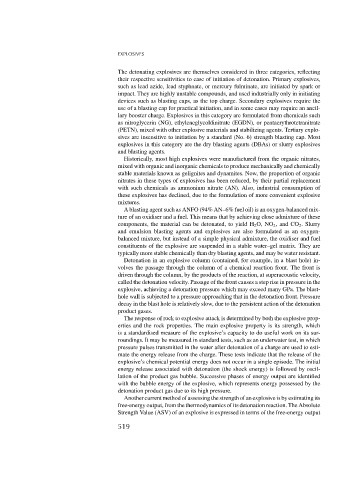Page 537 - Rock Mechanics For Underground Mining
P. 537
EXPLOSIVES
The detonating explosives are themselves considered in three categories, reflecting
their respective sensitivities to ease of initiation of detonation. Primary explosives,
such as lead azide, lead styphnate, or mercury fulminate, are initiated by spark or
impact. They are highly unstable compounds, and used industrially only in initiating
devices such as blasting caps, as the top charge. Secondary explosives require the
use of a blasting cap for practical initiation, and in some cases may require an ancil-
lary booster charge. Explosives in this category are formulated from chemicals such
as nitroglycerin (NG), ethyleneglycoldinitrate (EGDN), or pentaerythrotetranitrate
(PETN), mixed with other explosive materials and stabilizing agents. Tertiary explo-
sives are insensitive to initiation by a standard (No. 6) strength blasting cap. Most
explosives in this category are the dry blasting agents (DBAs) or slurry explosives
and blasting agents.
Historically, most high explosives were manufactured from the organic nitrates,
mixed with organic and inorganic chemicals to produce mechanically and chemically
stable materials known as gelignites and dynamites. Now, the proportion of organic
nitrates in these types of explosives has been reduced, by their partial replacement
with such chemicals as ammonium nitrate (AN). Also, industrial consumption of
these explosives has declined, due to the formulation of more convenient explosive
mixtures.
A blasting agent such as ANFO (94% AN–6% fuel oil) is an oxygen-balanced mix-
ture of an oxidiser and a fuel. This means that by achieving close admixture of these
components, the material can be detonated, to yield H 2 O, NO 2 , and CO 2 . Slurry
and emulsion blasting agents and explosives are also formulated as an oxygen-
balanced mixture, but instead of a simple physical admixture, the oxidiser and fuel
constituents of the explosive are suspended in a stable water–gel matrix. They are
typically more stable chemically than dry blasting agents, and may be water resistant.
Detonation in an explosive column (contained, for example, in a blast hole) in-
volves the passage through the column of a chemical reaction front. The front is
driven through the column, by the products of the reaction, at superacoustic velocity,
called the detonation velocity. Passage of the front causes a step rise in pressure in the
explosive, achieving a detonation pressure which may exceed many GPa. The blast-
hole wall is subjected to a pressure approaching that in the detonation front. Pressure
decay in the blast hole is relatively slow, due to the persistent action of the detonation
product gases.
The response of rock to explosive attack is determined by both the explosive prop-
erties and the rock properties. The main explosive property is its strength, which
is a standardised measure of the explosive’s capacity to do useful work on its sur-
roundings. It may be measured in standard tests, such as an underwater test, in which
pressure pulses transmitted in the water after detonation of a charge are used to esti-
mate the energy release from the charge. These tests indicate that the release of the
explosive’s chemical potential energy does not occur in a single episode. The initial
energy release associated with detonation (the shock energy) is followed by oscil-
lation of the product gas bubble. Successive phases of energy output are identified
with the bubble energy of the explosive, which represents energy possessed by the
detonation product gas due to its high pressure.
Another current method of assessing the strength of an explosive is by estimating its
free-energy output, from the thermodynamics of its detonation reaction. The Absolute
Strength Value (ASV) of an explosive is expressed in terms of the free-energy output
519

